Dolphin Fleet Naturalist Notebook 15 May to 21 May
May 15 started out bright with Northwesterly winds and an ocean swell. In the morning we ventured far to the East of Stellwagen Bank where we sighted 12 humpback whales, 1 finback whale and over 500 Atlantic white-sided dolphins. It was a great opportunity to see the dramatic size difference and varying features of toothed and baleen whales. Toothed whales, with the exception of the sperm whale, are generally smaller than baleen whales, have teeth of varying number and shapes, and one nostril called a blowhole on top of their head. Toothed whales use their teeth to grasp onto their prey before swallowing them whole. They are group or family oriented. These groups called pods, schools or gams are often comprised of family members that swim, feed, rest and socialize together.
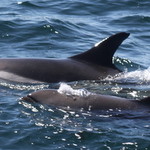
Baleen whales are some of the largest animals on earth. They have paired blowholes on top of their head, appear to be more solitary than toothed whales and have a built in strainer called baleen inside their mouths. The baleen plates grow downward from the whale’s upper jaw in very compact vertical arrays. When a large whale finds a large school of small fish or shrimp, they drop their lower jaw, engulfing thousands of gallons of sea water and prey. Their throat pleats stretch out like a great accordion allowing for more. With a mouth full of food and water, the whale closes its mouth until only some of the baleen is showing and pushes with its tongue while closing the throat pleats. Water pours out through each individual baleen plate. The prey cannot escape, for the inner edges of the baleen has thousands of overlapping hair-like edges forming a fine mesh net, sieve or strainer. The prey remains entrapped inside the whale’s mouth and is swallowed whole in one gulp.
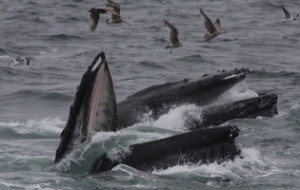
Today most of the large whales are diving for long periods of time. The exceptions are the dolphins and a pair of humpback whales, Loon and her young calf.

By afternoon the winds and swell increased. Fewer whales were sighted but the activity level increased. The DVIII watched a small Minke whale breach–not a common sight! Both the DVIII and the Portuguese Princess sighted Rapier, a mature female born to Ase in 1989 who has returned with 4 calves. Rapier was kick feeding, surfacing through a cloud of bubbles with her mouth wide open, allowing all a spectacular look at her baleen plates.
By May 16 the offshore swell had diminished and we returned to an area called the Triangle where whales had been sighted during the week. However few birds and fewer whales were in the area. We then ventured to the Southwest corner of Stellwagen Bank, a long trek, but an area where we often have watched whales. While you cannot see the Bank itself, there are visible surface signs that we are near. High flyers and buoys attached to lobster pots dot the waters surface and small boats outline the drop-off on the southwest corner in hopes of catching fish- later in the season the prize catch- giant blue fin tuna. The Bank rises up from depths of 600’, leveling off at an average of 100’below the water’s surface. The seafloor beneath is diverse, created some 14,000 years ago during the retreat of the last Great Ice Age. The sandy bottom is scattered with ridges and troughs, the water constantly moving, transports nutrients and plankton, a food source for fish, marine birds and whales. Here we sighted 3 small Minke whales and a large finback whale.
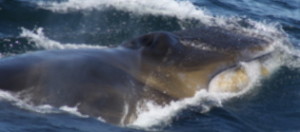
By afternoon we return to the Triangle and just west of it we sight a small pod of dolphins and 2 humpback whales. We are reminded of how fast changes occur in this patchy dynamic environment as we watch whales that were not there-or anywhere within our range of vision- a few hours before. Rapier and a small juvenile were moving steadily, occasionally lifting their flukes before diving.
May 17 was bright with light southwesterly winds. Once again we headed east from Race Point to the Triangle where we sighted 8 humpback whales and 2 finback whales. The whales were traveling and only occasionally lifting their tails. Two of the humpbacks were small unknown whales, perhaps only 1 or 2 years old. There also were two mature females: Shark, first sighted in 1984 and a mother of 9; and Loon, first sighted in 1985 and a mother of 5.

By afternoon only 3 humpbacks were sighted, Loon and calf and a small unknown. However there was a small pod of dolphins and one finback whale. The finback’s long, sleek body seemed to slide through the water with little to no resistance. After a few breaths, the whale arched and slipped beneath the water’s surface. The finback is long, streamlined (called “razorbacks” by whalers ) and one of the fastest of all baleen whales. It is second in size only to the giant blue whale and can reach lengths of 85 feet (25 meters). Its body is light gray to brownish-black on the back and sides. The lower jaw, gray or black on the left side, is bright white on the right side giving the finback whale the distinction of being the only animal divided in half- lengthwise- by color. This asymmetrical coloration extends to the whale’s baleen plates as well. The prominent dorsal fin, located 2/3 down its back, is sickle-shaped.
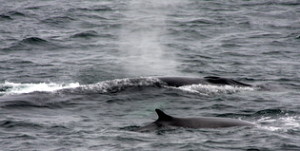
May 18 was overcast with moderate southeasterly winds. Today the whales were east of the Triangle, quite a distance offshore but seemed to be heading west. We sighted 2 humpback whales, Nile and Division, both mature females. Nile was born in 1987 to Mars and has returned with 3 calves; Division was born in 1991 to Orbit and has returned with 1 calf. The activity increased in the afternoon as did the number of whales. We sighted 8 humpback whales in the same area but all were actively feeding. Nile and Division were resighted from the morning’s watch. Also in the mix were Zeppelin, Glostick, and Fulcrum. This is more dependent on food availability than time of day as humpback whales do not sleep as we know it. They are mammals who spend most of their lives underwater. They are considered ‘voluntary’ breathers- with each breath a conscious effort on their part. Furthermore, this area is a historic feeding ground and humpback whales feed often in preparation for a long southbound migration. Like many whales, humpbacks are international citizens, migrating great distances each year. The migration relates to the life cycle of the whale, as they feed during the summer and breed and calve during winter months. In the North Atlantic, the humpback whale ranges from tropical waters in the Caribbean to Arctic waters. During the winter, the majority of the population congregates to mate and calve among the reefs and islands of the West Indies. Humpbacks leave the breeding areas in spring to migrate to several high-latitude feeding areas during spring and summer months including the Gulf of Maine, the Gulf of St. Lawrence, Newfoundland-Labrador, Greenland, Iceland, and Norway. Fidelity to feeding areas is well documented. While on the tropical breeding grounds, humpbacks from all feeding areas can be seen swimming side-by-side – each year, the humpback whales of Cape Cod return to their ancestral feeding grounds- as do their calves once they leave their mothers’ side.

May 19– no trips due to wind and rain
May 20 was bright with a hefty ocean swell. We traveled east of Stellwagen Bank where we found 5 finback whales, a small pod of dolphins, 5-10 harbor porpoise and 1 humpback whale. The harbor porpoise is a toothed whale and ranges in size from 4 to 6 feet. They are inconspicuous and not likely to venture near the boat. With persistence, we finally are able to see the small porpoise with its triangular dorsal fin and dark gray body. Unlike the dolphins, the porpoise rarely if ever bow rides and is seen in small groups of a few individuals. The porpoise feeds on small schooling fish that are feeding on zooplankton. The porpoise grabs the fish with its teeth and swallows it whole.
Zipper, a mature female humpback has returned to the waters off Provincetown with 6 calves. This morning she was kick feeding, blowing large bubbles nets, or occasionally lunging across the water’s surface. By afternoon several humpbacks had moved into the area and most were feeding actively. Ventisca, fist sighted in 2001 and a mother of 1 was kick feeding as was Sloop and Tear. Sloop, born to Cerdo in 1987 is a mother of 3 and Tear is a mature male first sighted in 1990. Anchor, a mature female born to Olympia in 1983 and a mother of 5, also was feeding in the area with Thumper, Grackle and Division and 2 small unknown humpbacks.
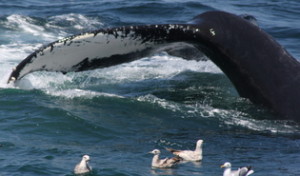
May 21 was bright and with a diminishing offshore swell as we headed east once again. We found 9-11 humpbacks, 1 finback and 1 Minke whale. All of the humpbacks were feeding energetically on the surface. Zipper, sighted yesterday, was joined by Stub, a mature male, Ganesh, a mature female born to Loon in 1998 and a mother of 2, Nile, a mature female born to Mars in 1987 and a mother of 3 and Xylem, first sighted in 2003.
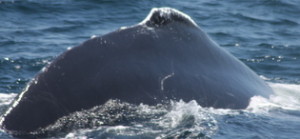
There were several birds in the area, primarily gull species but also several common terns. The tern’s graceful flight earned it its nickname of “sea swallow.” It is a familiar sight on Cape Cod, particularly in areas where protected nesting sites exist. The common tern flies gracefully over the water with deliberate wing beats, its head turned down at a right angle to its body. When it sights a fish, it dives down to catch its prey. The common tern is easily identified by its striking black cap, pale gray back and wings, red bill, and deeply forked tail.
On the afternoon watch we return to the same area and the humpback whales continued to feed at the surface with clouds of birds hovering above. Walrus, a large male first sighted in 1982 and Tongs, a mature female first sighted in 1989 who has returned with 3 calves were feeding together. Tongs would slap her flukes on the surface, dive, a bubble net would rise with both whales surfacing with mouths wide open. Leukos, Rapier and Grackle also were feeding in the area. So ends another week of whale watching in a year that seems more unpredictable than most!





